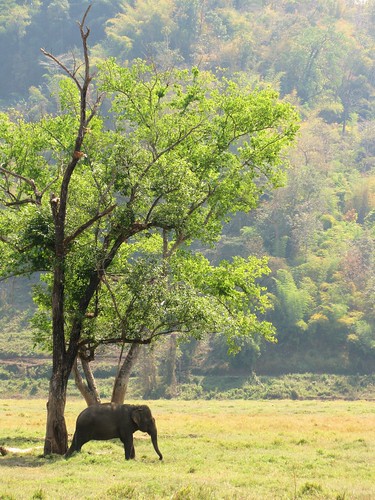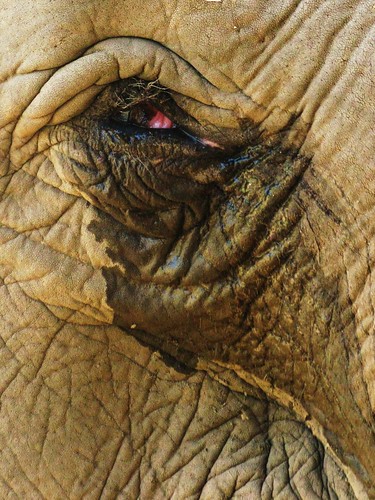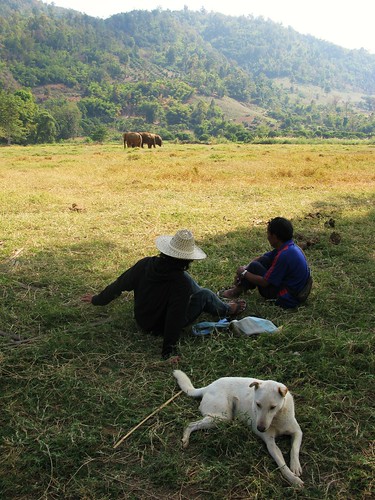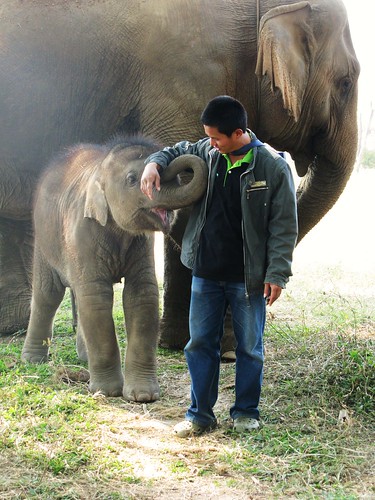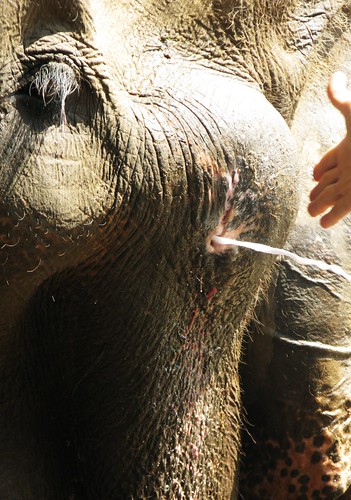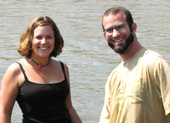Where the wild things limp
It’s near impossible to visit Chiang Mai, Thailand and not spend every day checking something off the traveler’s list of must-dos. It seems as lazy and cliché as a Snuggie to keep doing what everyone else does – whether it’s catching a muay thai match or taking a cooking class – but it’s all been so much fun. There’s a reason these are well-trod tourist paths. Todd and I are content to be part of the herd.
Before leaving on this round-the-world trip, most friend’s tips for Thailand included that we go on an elephant trek. My do-gooder super-ego immediately started grumbling like Marge Simpson, leery of an animal-dependent tourist attraction that’s not a preserve or national park.
So I picked up the Fate of the Elephant by Douglas Chadwick. Though a bit old, published in 1994, it’s an extraordinary book filled with cautionary tales about ivory trade, poaching, logging servitude, and the no-one-wins conflict between struggling farmers and the ravenous, habitat-deprived elephants that destroy crops. Chadwick rarely preaches, letting his stories and research speak for themselves. Reading Fate of the Elephant convinced me that there had to be something more responsible than a trek for my Thai elephant encounter.
That’s where Dave Shefferman comes in. Dave is another do-gooder, founder of volunteering portal One Brick. Dave recommended a day at Elephant Nature Park, a sanctuary for a few dozen of Thailand’s 5,000 endangered Asian elephants, run by a determined and tiny Thai woman named Lek. Dave promised that the Park would be the ideal place to get the real story on elephants without the circus acts. He’s also a LonGuylander who made the wise decision to escape to San Francisco, so I trust his judgment.
An early morning pickup from our guesthouse brings Todd and I and a dozen other travelers to one of Chiang Mai’s massive markets, to pick up the food that will later become a snack for the elephants and lunch for us. For fifteen minutes, we heft bags filled with produce into the pickup truck’s cargo bed, bucket brigade-style. Our guide explains that this truckload – which is more fruit and vegetables than the average American eats in a year (about 250 pounds) – is just a small portion of the food the Park’s elephants will consume today. The comparatively miniscule pile of people food goes into the pickup’s front seat.
After a long ride through an increasingly rural landscape, billboards suddenly sprout along the roadside. They show nervously laughing elephant-riding tourists grabbing tight to their bamboo howdah seating, and elephants plodding through anthropomorphic behaviors like kicking soccer balls, dunking basketballs with their trunk, painting, and playing darts. I’m content when we leave the elephant shows behind and arrive at Elephant Nature Park.
We start off at the Park with a introductory workshop about how to safely feed and bathe the elephants, which weigh between three and six-ish tons as adults. Our group gets the same coaching as two groups of preteens from an international school, the educational equivalent of a Benetton ad.
Our heads full of warnings, we assemble on a raised bamboo deck for the first of the day’s two feedings. Most of the elephants at the Park survived traumatic lives, rescued from beatings or from working beyond their endurance. One elephant, Malai Tong, limps towards the feeding line, her back leg unnaturally bent, and part of her foot missing, disfigured by a landmine explosion while working as a beast of burden in a logging camp. Others have ragged ears, deep scars, or missing or partial tusks.
An elephant walks up to where Todd and I wait in the feeding line. A mahout, or elephant handler, lets us know this is Jokia, who has one of the more tragic stories. She was blinded in both eyes by a previous owner when she refused to continue logging after her baby was born and died on the job. The blinding wasn’t done to motivate Jokia, but to make her submissive enough to do the work she refused to do.
Feeding Jokia requires extra care. Her trunk weaves back and forth like a blind man’s cane, smelling for food and the people that she knows make the food appear. I grab a piece of food from the basket – maybe a whole unpeeled banana or entire shucked corn on the cob – and guide it to the tip of her trunk, which is an inventive combo of nose and upper lip.
Her trunk is covered in rough, dry, thick skin stippled with spiny hair. The heavy, warm, meat tube of a trunk is filled with a surprising strength and dexterity; when Jokia and I meet, the end of her trunk curls over the food and my hand. As Jokia pulls the food to her mouth, I’m left with a hand covered with elephant saliva and snot, dust turned mud, vegetable juice, bits of food, and seeds. It’s an episode of You Can’t Do That on Thai Television and I’ve been slimed.
Next, a guide takes us on a walk into the hill-framed fields, telling us about how long and hard the Park’s founder, Lek, worked to secure this land for the elephants. There’s nothing between us and the elephants but some napping mahouts, lazy dogs, and cracked trees. The mangled trees are stripped of lower leaves and branches, and much of their bark, by elephants using them as backscratchers. Juvenile elephants play fight, babies hide in the shadows of adults, dust is liberally tossed. As we watch, a group of meandering elephants turns our way.
Our guide calmly says, “See, there is the baby. And her mother and aunties. They come here now. They will feel safe. I am sure. But, if I start to run, you run! Ok?”
Within minutes we’re surrounded by a half-dozen elephants. For animals that lumber, an elephant’s long strides quickly cover ground. The baby seems to be the only one interested in us, leaning familiarly against our guide. As far as the adults seem concerned, we don’t have food, so we’re not interesting.
As we head to lunch, Todd and I notice two veterinary student volunteers, Stephanie Gore and Cassandra McLucas, helping the Park’s giddy, affable vet clean out an abscess in the face of Max, the Park’s oldest elephant and possibly the tallest elephant in Thailand. Max was hit by a car while working the tourist trade, leaving him with a stiff, unbending front leg, as well as deep abscesses that never heal, needing to be flushed multiple times a day.
Todd and I watch, gape-mouth with fascination, as Cassandra holds a tube tight into an abscess opening while Stephanie pumps in a sterilizing, antibiotic liquid. All the while Max, grown accustomed to this procedure, calmly waits until he’s told he can go. When the Park’s vet says “Okay!,” the tube is removed, often followed by a slow trickle of blood, pus, and cleansing fluid, or sometimes by a foamy geyser of the same biological cocktail. One of the vet students gently pushes on the skin surrounding the abscess opening until the goo stops oozing out, and they start again, flushing until the fluid runs clear.
It’s disgusting, like a giant pimple. It’s amazing, like fireworks. It’s disgustingly amazing, like an In-N-Out 100 x 100.
So, when’s lunch?
p.s. Max died in April 2009, just a few months after our visit, after living to the ripe old age of 70-something.
How you can help the elephants
Do these:
- Share this story with friends, especially anyone heading to Thailand or other countries where elephants roam, so they can learn more about more responsible options for interacting with elephants.
- Watch clips from the National Geographic video about Thai elephants, which includes more information about Lek’s work on elephant conservation.
- Foster an elephant (pick your elephant from the webpage) or Make a donation to Elephant Nature Foundation and Park.
- Visit the Park.
- Volunteer at the Park.
Skip these:
- Elephant rides, treks, and shows: They’re exploitative and harmful. The phaajaan, or “training crush” that is used to to tame elephants and make them submissive enough for tricks is pure torture. At the very least, if you insist on riding, only go bareback and one tourist per elephant – no matter what the “eco-tour” claims, the seat strains the elephant’s back and Asian elephants are not large enough to support multiple hefty tourists. Also, keep in mind that it’s highly unlikely that elephants paint figurative pictures without a lot of poking from their mahouts.
- Giving money to elephant touts and taking photos of street elephants: Elephants do not belong in cities and giving money to the touts only encourages them to keep their elephants turning tricks.
- Buying ivory: Tusks are illegally chainsawed off still-living elephants, an insanely painful and frightening procedure that usually leads to infection. How this still needs saying boggles the mind.
Photos from Elephant Nature Park, Chiang Mai, Thailand
If you can’t see the photo slide show above, view the photo set on Flickr.


